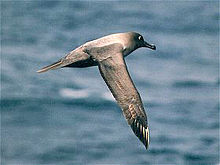Phoebetria
This article includes a list of general references, but it lacks sufficient corresponding inline citations. (April 2009) |
| Sooty albatross | |
|---|---|

| |
| Light-mantled albatross (Phoebetria palpebrata) | |
| Scientific classification | |
| Domain: | Eukaryota |
| Kingdom: | Animalia |
| Phylum: | Chordata |
| Class: | Aves |
| Order: | Procellariiformes |
| Family: | Diomedeidae |
| Genus: | Phoebetria Reichenbach, 1853 |
| Type species | |
| Diomedea fuliginosa[1] Gmelin, 1789
| |
| Species | |
|
Phoebetria fusca | |
The sooty albatrosses are small albatrosses from the genus Phoebetria. There are two species, the sooty albatross, Phoebetria fusca, and the light-mantled albatross, Phoebetria palpebrata.
Systematics
The sooties have long been considered distinct from the rest of the other albatrosses, and have retained their generic status through the many revisions of the family over the last 150 years. They have traditionally been thought of as primitive, sharing some morphological features with the other petrel families. However, molecular work examining the mitochondrial DNA has shown that the taxon is related to the mollymawks, and that the two taxa are distinct from the great albatrosses and the North Pacific albatrosses.[2]
| Common name | Scientific name and subspecies | Range | Size and ecology | IUCN status and estimated population |
|---|---|---|---|---|
| sooty albatross, dark-mantled sooty albatross or dark-mantled albatross | Phoebetria fusca (Hilsenberg, 1822) |
southern Atlantic Ocean (Gough Island and the Tristan da Cunha group) and Indian Ocean
|
Size: Habitat: Diet: |
EN
|
| light-mantled albatross, grey-mantled albatross or the light-mantled sooty albatross | Phoebetria palpebrata (Forster, 1785) |
circumpolar pelagic distribution in the Southern Ocean
|
Size: Habitat: Diet: |
NT
|
Description
Both have distinctive blackish plumage over the head, wings and bellies. The sooty albatross has a dark back and mantle as well, whereas the light-mantled has an ashy-grey mantle, back and rump. The two species can also be told apart by the narrow yellow line on the sooty's bill. Despite the differences between the two species they can be hard to tell apart at sea, especially in poor light. Both species have a white incomplete eye-ring, dark bills and grey feet. They are among the smallest albatrosses, with wingspans of 200 cm (79 in) and are very narrow as well. The light-mantled, at 2.5 to 3.7 kg (5.5–8.2 lb) and sometimes to 4.6 kg (10 lb), is larger than the sooty, at 2.4 to 2.7 kg (5.3–6.0 lb). Unique amongst the albatrosses they have long stiff wedge shaped tails, the purpose of which is unclear but seems to be related to their ability to dive for food.

Reproduction
The two species, like most
Range and habitat
Sooty albatrosses nest on islands in the
Conservation
The two species face similar threats,
See also
References
- ^ "Diomedeidae". aviansystematics.org. The Trust for Avian Systematics. Retrieved 2023-07-27.
- JSTOR 4088857.
Further reading
- Brands, Sheila (14 Aug 2008). "Systema Naturae 2000 / Classification – Genus Phoebetria –". Project: The Taxonomicon. Retrieved 22 Feb 2009.
- Brooke, M. (2004). "Procellariidae". Albatrosses And Petrels Across The World. Oxford, UK: Oxford University Press. ISBN 0-19-850125-0.
- Tickell, W. L. N. (2000). Albatrosses. Robertsbridge, UK: Pica Press. ISBN 1-873403-94-1.


